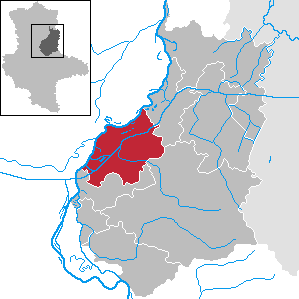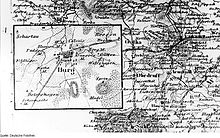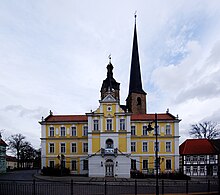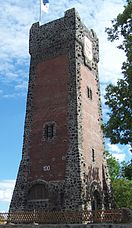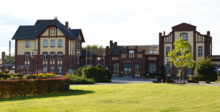Castle (near Magdeburg)
| coat of arms | Germany map | |
|---|---|---|

|
Coordinates: 52 ° 16 ' N , 11 ° 51' E |
|
| Basic data | ||
| State : | Saxony-Anhalt | |
| County : | Jerichower Land | |
| Height : | 46 m above sea level NHN | |
| Area : | 164.05 km 2 | |
| Residents: | 22,406 (December 31, 2019) | |
| Population density : | 137 inhabitants per km 2 | |
| Postal code : | 39288 | |
| Area code : | 03921 | |
| License plate : | JL, BRG, GNT | |
| Community key : | 15 0 86 015 | |
| LOCODE : | DE BUR DE BGX |
|
| NUTS : | DEE06 | |
| City structure: | 9 districts and 4 residential spaces | |
City administration address : |
In the old barracks 2 39288 Burg |
|
| Website : | ||
| Mayor : | Jörg Rehbaum ( SPD ) | |
| Location of the district town of Burg in the district of Jerichower Land |
||
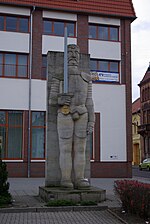
Burg is a unified municipality and the district town of the Jerichower Land district in Saxony-Anhalt . It is a Roland city and is also called the city of towers .
geography
Burg is located about 25 kilometers northeast of the Saxony-Anhalt state capital Magdeburg . Berlin is about 100 kilometers to the northeast. Important bodies of water in Burg are the Ihle River and the Elbe-Havel Canal . The Elbe forms the north-western city limits. The area around the city was shaped by the Ice Ages, to which the landscape formation of the Fläming goes back, on whose foothills lies the castle.
City structure
| Districts | Incorporated localities | Living spaces |
|---|---|---|
| • Blumenthal • Gütter • Madel |
• Detershagen • Ihleburg • Niegripp • Parchau • Schartau • Reesen |
• Obergütter • Überfunder • Forest peace • Forest school • Brehm |
Place name
The origin of the name Burg is unclear. The older spelling is Borg and also the current dialectal pronunciation is more of an O as a U . The triangular market square (today Am Markt ) is interpreted as evidence of Slavic founding. Thus, Bor (Slavic pine forest ) offers itself as a place name, similar to Kleinburg near Breslau, here too there was Borck with O as a transitional form. However, the nearby Gardelegen also has a triangular market, but is considered a Germanic foundation. The triangular market could also be due to the fact that the current dike road leads into a swampy area. Deich-… means unanimous pond and even today the patchwork park following Deichstraße is full of ponds and regularly flooded by the Ihle . A traveler from Berlin to Magdeburg or Zerbst would have taken a route on the terminal moraine of Berliner Straße that differs significantly from the straight line, but is dry. However, an actual castle was not found.
history
The town of Burg was first mentioned in a document on October 1, 948. The settlement was favored because the heights of the northwestern Fläming above the water-bearing Ihle and Elbe lowlands with its partially fertile and wild terrain offered favorable conditions for existence. The prehistory of Burg began palpably with the Neolithic (Younger Stone Age), around the beginning of the 3rd millennium BC. Archaeological finds from the Bronze Age and then the Iron Age document the further early history of Burg. Research results from 2010 locate the settlement Mersovium , which Ptolemy had listed in his Atlas Geographia around the year 150 AD , in the Burg area.
After the Germanic population emigrated during the migration period, Slavs settled near the Ihle crossing. The Ottonian kings began their policy of conquest in the 10th century. In 928, Heinrich I conquered Brandenburg . His son Otto founded the Diocese of Brandenburg in 948 . The town of Burg is mentioned for the first time in the deed of foundation. In order to secure their influence, Albrecht the Bear and Archbishop Wichmann in particular moved Flemish settlers to the Burger Land. They founded the lower town in Burg, built the Nicolaikirche and introduced cloth-making. The Flemish immigrants brought advanced forms of economy and important trade relations with them from their homeland. By building dykes on the Elbe and draining the extensive lowlands, they increased the amount of agricultural land around the city. Their cattle breeding, beer brewing and the production of woolen cloth became a basis for the flourishing development of the town of Burg. This is shown by the fact that there was already a cloth defeat in Magdeburg in 1224 and this was solemnly confirmed by the then Archbishop Albert.
On both sides of the banks of the Ihle, an upper and lower town developed under separate administration. In the early 13th century, both settlements were fortified together (new defensive walls with towers). At that time, Burg was already one of the economically most important and most defensive cities in the region and in the 15th century it was the third largest city in the ore monastery of Magdeburg after Magdeburg and Halle .
The Thirty Years War brought much suffering to the people living in Burg. Numerous billets and passages, which repeatedly led to fires, an artillery bombardment and a general pillage in 1644 brought the city to the brink of doom, from which it was not protected by the letter of protection from General Pappenheim. The general marched through Burg at the end of January 1631 to help conquer Magdeburg. In the Peace of Prague in 1635, Kursachsen Castle was awarded, but in 1687 it was sold to Brandenburg-Prussia by Duke Johann Adolf I of Saxony-Weißenfels . The city and the Burg office went to the surrounding Duchy of Magdeburg . Burg was located in the Jerichower district and was henceforth directly subordinate to the government of the duchy as a so-called immediate city . The immigration of Palatine, Walloons and Huguenots , that is, of Reformed religious refugees who found refuge here, supported this upward development, which was promoted by Brandenburg-Prussia . The Huguenots, for example, brought new, innovative forms of handicraft to this region.
In 1817 the district of Jerichow I was formed, whose seat became the castle. In 1924, Burg formed an urban district, but retained the administrative seat for the district, which was renamed District Burg after the Second World War and reintegrated into the castle in 1950. In 1994 the city came to the district of Jerichower Land.
With the expansion of the transport system - in 1820 a country road was built from Burg to Magdeburg - and the beginning of industrialization , the city continued to advance economically. The first steam engines were in operation in Burg in 1836. On August 7, 1846, the inauguration of the Burger Bahnhof on the new Berlin – Magdeburg railway line was celebrated. Finally, the construction of the Ihle Canal in 1871 created further conditions for extensive industrial development. In 1883 the shoe factory “Tack u. Cie ". The company Conrad Tack u. Until the end of the Second World War, Cie was the largest shoe manufacturer in Europe with up to 4,000 pairs of shoes produced every day. The Burger Schlachthof was built from 1898 to 1899. In 1917, for example, 1,500 cattle, 1,200 calves, 10,000 pigs, 700 sheep and 150 horses were slaughtered there.
During the Second World War, the castle was relatively little destroyed. A group of communists, social democrats and bourgeois democrats also managed to surrender the city to the Soviet army without a fight and thus prevented the city's destruction in the last days of the war. This group included the communists and former members of the city parliament for the KPD August Heisinger, a lathe operator and Willi Steiger, a cutter by trade. In addition to master gardener Georg Schindler, also a member of the KPD, the group also included the social democrat and master carpenter Willi Stollberg, who was also a member of the city parliament for his party before the Nazi era, and the social democrat and high school councilor Dr. Hubert Tschersig. In addition, the well-known gold molding manufacturer Georg Lorenz, W. Kunze, the burger publisher Theodor Hopfer, the lubricating grease manufacturer Siegfried Stöckel, who had also previously been a member of the city parliament for a bourgeois list, and the cloth merchant Ullrich Deutsch, in whose rooms the decisive meeting on May 2, 1945, three days before the handover, took place.
In 1953, a radio transmission system was built east of Burg bei Brehm , which was subsequently expanded to become one of the largest in Germany.
A Stalin monument was ceremoniously unveiled in 1954 on today's Rolandplatz . It was one of the last monuments erected in the GDR after Stalin's death and was removed after just a few years.
From 1949 to 1990, the largest youth workshop in the GDR was located in Burg .
In 1991 the largest industrial park in the district was opened. From September 17th to 19th, 1999 the first Burger Rolandfest took place with the unveiling of the new Roland figure . From June 27 to 29, 2003, Burg hosted the 7th Saxony-Anhalt Day .
On May 25, 2009, the city received the title “ Place of Diversity ” awarded by the federal government .
Some important people stayed in the town of Burg. Theodor Fontane worked as a pharmacy assistant in Burg and the military theorist Carl von Clausewitz , whose teachings on war are taught in almost all military universities worldwide, was born here. The internationally renowned grave of Carl von Clausewitz can be found in the Burger Ostfriedhof. A memorial is located in his parents' house at Schulstrasse 12. The city library at Berliner Strasse 38 and a primary school in the Burg-Süd district bear the name of the writer Brigitte Reimann , who was born in Burg in 1933 . The well-known organist and composer Joachim a Burck was born in Burg in 1546. The district music school and a street bear his name. Numerous churches, remains of walls and gate towers bear witness to the great past of this city.
Incorporations
Ihleburg was incorporated on May 25, 2002. This was followed on December 1, 2002 by Detershagen, Niegripp, Parchau and Schartau. On July 1, 2009 Reesen was incorporated.
Population development
|
|
politics
City council
After the local elections on May 26, 2019, with a turnout of 47.5%, the 36 seats of the Burg City Council were distributed as follows:
| Party / list | Share of votes | Seats | +/- | Allocation of seats in the city council from 2019 |
| CDU | 31.1% | 11 | - 4th | |
| SPD | 16.8% | 6th | - 2nd | |
| The left | 16.7% | 6th | ± 0 | |
| AfD | 16.2% | 6th | + 6 | |
| Alliance 90 / The Greens | 4.9% | 2 | + 1 | |
| FDP | 4.9% | 2 | + 1 | |
| FWG Endert | 4.4% | 1 | - 2nd | |
| Burger Free Voters | 2.8% | 1 | ± 0 | |
| EM * | 2.1% | 1 | ± 0 |
* Individual mandate holder
Three factions have formed:
- SPD / LINKE / Greens / BFW / EM (16 members)
- CDU / FDP (13 members)
- AfD / FWG Endert (7 members)
The chairman of the city council is Markus Kurz (CDU). The first deputy chairman is Karl-Heinz Summa (SPD). Barbara Bester (Die Linke) is the second deputy chairwoman.
Five standing committees have been set up by the city council. The decision-making committees include the main committee , the economic and public procurement committee , the finance and auditing committee , the building and regulatory committee and the culture, tourism and social committee. There is also the advisory environmental committee. The chairman of the main committee is the mayor Jörg Rehbaum (SPD).
mayor
In the main election on January 17 and the necessary runoff on January 31, 2010, Jörg Rehbaum ( SPD ) was elected with 54.71%, according to the official final result. The inauguration and appointment for seven years took place in the city council meeting on February 18, 2010. Until then, Jörg Rehbaum was urban planner in the Magdeburg city administration and honorary mayor of the Niegripp community, where he received 84.4% of the votes. On November 6, 2016, Jörg Rehbaum was re-elected with 82.0% of the vote.
- Chronology of the (lord) mayors
|
|
coat of arms
Blazon : “In blue a golden castle with a battlement wall and two tinned round towers with black arched windows (1: 2), with red gate wings and raised black portcullis; a golden Mother of God enthroned on the wall between the towers, holding the baby Jesus in her right arm. "
The coat of arms is based on the Magdeburg coat of arms : Mary on the city wall with a victory wreath as Mary on the city wall with the child.
Corperate Identity Logo
The corperate identity logo of the city of Burg was created in 2006. It shows stylized houses and towers set off in a large B, which represent a symbol for the cityscape of the historic city center and thus derive the nickname "City of Towers". The logo may be used by third parties for their own purposes without the approval of the Burg City Council.
Town twinning
Together with Gummersbach, there are partnerships with Afandou and La Roche-sur-Yon.
-
 Afandou on Rhodes in Greece
Afandou on Rhodes in Greece
-
 Gummersbach in North Rhine-Westphalia (since November 1, 1990)
Gummersbach in North Rhine-Westphalia (since November 1, 1990) -
 La Roche-sur-Yon in France (since 2005)
La Roche-sur-Yon in France (since 2005) -
 Tira in Israel (since September 15, 2001)
Tira in Israel (since September 15, 2001)
Culture and sights
Due to the early development and the strategic location, the town of Burg was equipped with fortifications early on. Some of these structures have been preserved, and the towers in particular still shape the cityscape today.
The holiday route " Romanesque Road " leads through Burg with the stations Upper and Lower Church (see buildings) and the Road of Rolande .
Attractions
Churches / sacred buildings
- Church of St. John (Catholic, built 1904–1906)
- Church of Sankt Nicolai - lower church (Evangelical-Lutheran, Romanesque granite block building built between 1162 and 1186), station on the Romanesque Road
- Sankt Petri Church (Evangelical Reformed Church, 13th century)
- Church of Our Dear Women - Upper Church (Evangelical-Lutheran, first mentioned in 1186), station on the Romanesque Road
- Chapel in the Jewish cemetery (donated by Alfred Zweig in 1911 )
- Second synagogue (built in 1851, Bruchstrasse 9)
additional
- Railway station (opened in 1846)
- Berlin Tower (14th century)
- Bismarck Tower , a 27 m high observation tower , popularly known as the Fläming Tower (inaugurated in 1907)
- Brigitte Reimann Burg City Library
- Freedom Tower (first mentioned in 1530)
- Remains of the city fortifications
- Historic tannery (tower house around 1450)
- Hexenturm (11th century)
- Kino Burg Theater (oldest purpose-built cinema in Germany that is still in operation today; opened as Lichtspiele / Palast-Theater on June 3, 1911)
- Historic town hall (first mentioned in 1224)
- Burger Roland de Ries (replica of the historic Roland, head of the original in the town hall)
- Historic post office (around 1900)
- Slaughterhouse (built 1898–1899 on a total of approx. 11,000 m² for 350,000 marks)
- Guiard shoe factory (1924 by Arthur Korn )
- Schuhfabrik Tack u. Cie. (1889–1906)
- Monument to the drummer , a legendary figure in Burger
- Villa Zweig (Art Nouveau)
- Villa Krojanker (1924 by Arthur Korn in the New Building style )
- Water tower on the vineyard , built in 1902
- Home of the Clausewitz family (replica, today the Carl von Clausewitz memorial)
- Pieschelsche Institute
Parks
There are two parks in Burg, the Flickschupark and the Goethepark .
Under the motto " ... embraced by gardens ", the 4th State Garden Show in Saxony-Anhalt took place in Burg from April 21 to October 7, 2018 . The focus of the garden show was on the four core areas of Goethepark, Weinberg, Ihlegärten and Flickschupark.
Monuments
- Memorial stone in the Jewish cemetery on New Zinnern for the Jewish girl Anne Frank , which in March 1945 in Bergen-Belsen was killed
- Soviet honor grove on the Westfriedhof for 372 prisoners of war and women and men who had to do forced labor , as well as for Red Army soldiers who died in 1945 and 1946
- Memorial complex on the New Cemetery for the victims of fascism and anti-fascists who died after 1945
- Carl von Clausewitz monument in the courtyard of the Clausewitz memorial in Schulstrasse / Große Brahmstrasse. The original location of the monument was from 1980 in front of the Hotel - Stadt Burg on Rolandplatz
- Memorial stone in the Goethepark in honor of Heinz Meynhardt , inaugurated on October 24, 2009
Economy and Infrastructure
Burg is the seat of the Burg District Court and the Burg correctional facility . Progroup has been operating a corrugated board plant in Burg since 1998 , which has also been supplied with corrugated board base paper by a neighboring paper machine since 2001.
Traditional company
In 1917 the kitchen company Burger Küchenmöbel GmbH was founded by Otto Aßmann, who initially manufactured kitchen furniture by hand, and built-in kitchens have been available since 1960. Burger Küchenmöbel GmbH is a company of the baumann group, to which Bauformat Küchen GmbH & Co.KG also belongs. Together, the two companies with around 1,000 employees at two locations produce over 240 million euros in sales and are therefore among the TOP 10 German kitchen furniture manufacturers.
The Knäcke factories have existed in Burg since 1931 and were the first of their kind in Germany. These were relocated to Burg by their founder, the nutritionist Wilhelm Kraft, from Berlin-Lichterfelde (founded there in 1927). Burger Knäcke GmbH & Co. KG has been part of the Brandt Group since 2001 . The Burger Knäcke-Werke mostly produce crispbread and rusks . Around 150 people are currently employed there.
The Burg Walzwerk has specialized in the manufacture of stainless steel products for years. Founded in 1908 as “Berlin-Burger Eisenwerke” (BBE), since 1937 “Sheet rolling mill” and since 1954 “Sheet rolling mill for stainless and tool steels”. In 1990 "Walzwerk Burg GmbH" was founded. From 1997 to 2012 it belonged to the Georgsmarienhütte Holding GmbH group of companies . Since January 1, 2009 it has been operating under the name Edelstahl Service Center Burg GmbH . On January 1, 2013, the company was sold to private investors.
Transport links
The Castle railway station lies on the railway line between Berlin and Magdeburg , and is the regional express -line Magdeburg - Brandenburg - Potsdam - Berlin - Frankfurt (Oder) and the regional train -line ( Genthin -) Burg - Magdeburg - Helmstedt - Braunschweig served. Burg is also the stop of the weekly Harz-Berlin-Express on the Berlin - Magdeburg - Halberstadt - Ilsenburg route . Important traffic axes are the federal highways 1 , 246a and the federal highway 2 as well as the Elbe-Havel Canal . There is a special airfield on the southern outskirts of the city .
military
Burg has also been a garrison town since the 18th century . There were three barracks in total . Only one is used for military purposes, the Clausewitz barracks of the Bundeswehr , in which the logistics battalion 171 and the 8th company of Feldjägerregiment 1 are housed. The area in the old barracks dates from the time of the Prussian army . This barracks was built around 1902 and is now an administrative center, among other things. The former Fürst-Leopold-von-Anhalt barracks from 1936, like the Clausewitz barracks, was built during the armament of the Wehrmacht . After 1945 it was occupied by Soviet troops until the withdrawal due to the two-plus-four contract in the early 1990s . Today there is an asylum seekers home in one part.
Transmitting system for long and medium wave
In the district of Brehm there is a large transmitter system for radio in the long and medium wave range, the Brehm radio office. The most striking structures of this complex are a 324 m high guyed steel lattice mast that carries a rhombus antenna for medium waves, a 210 m high guyed tubular mast, a 60 m high HP (horizontally polarized) antenna on six self-supporting steel lattice masts, and the 55 m high triangular antenna (K 1) on three guyed steel lattice masts. A second 210 m high tubular mast was blown up on June 22, 2006.
During the GDR era, the programs of the propaganda stations Deutscher Freiheitssender 904 and Deutscher Soldatensender 935 were broadcast from here.
media
- Der BurgSpiegel (discontinued - the last issue was published on February 17, 2019)
- Burger people's voice
- SKB - Stadtkanal Burg (broadcasting was discontinued in 2009 after bankruptcy)
Personalities
Honorary citizen
- Wilhelm Nethe , long-time mayor of Burg, appointed in 1881
- Otto von Bismarck , Chancellor of the German Empire , appointed on March 14, 1895
- Hermann Matern , Burger politician of the KPD and SED, appointed in 1963
sons and daughters of the town
- Joachim a Burck (1546–1610), composer
- Bernhard Kühns (1682–1729 / 1730), educator, cantor and Protestant pastor
- Johann Christoph Christian Rüdiger (1751–1822), camera and linguist as well as university professor
- Friedrich Wilhelm von Kleist (1752–1822), Prussian colonel
- Heinrich Ludwig Lehmann (1754–1828), writer and journalist
- Carl von Clausewitz (1780–1831), Prussian general and important military theorist
- Johann Christian Jüngken (1793–1875), surgeon, ophthalmologist and university professor.
- Justus Ludwig Jacobi (1815–1888), Protestant theologian
- Wilhelm Henckel (1825–1910), German bookseller, translator, publisher and publicist
- Rudolph Melchior (1836–1867), artist
- Hermann Eggert (1844–1920), architect
- Hermann Riedel (1847–1913), composer and conductor
- Paul Nethe (1849–1926), infantry general
- Hermann Paasche (1851–1925), politician (DVP)
- Hermann Paul Reisshaus (1855–1921), politician (SPD) and member of the Reichstag
- Ferdinand Kurlbaum (1857–1927), physicist
- Ernst Borkowsky (1860–1947), pedagogue, historian and literary scholar
- Paul Herrmann (1866–1930), Germanist
- Gustav Stollberg (1866–1928), politician ( SPD ) and Member of the Bundestag ( Prussia )
- Walter Rieseler (1890–1937), aviation pioneer and inventor
- Gustav Schulze (pilot) (1891–1932) aviation pioneer
- Hermann Matern (1893–1971), politician ( KPD , SED ), MdL ( Prussia ), Vice President of the People's Chamber
- Karl Adler (1894–1966), gynecologist, head of the regional women's clinic in Bochum
- Ernst Friedrich Schumacher (1896–1958), SPD functionary
- Gustav Stollberg (1898–1978), politician (SPD), Lord Mayor of Salzgitter and MdL ( Lower Saxony )
- Walter Paatz (1902–1978), art historian
- Walter Bohne (1903–1944), resistance fighter against National Socialism, communist
- Gerhard Westram (1907–1977), federal prosecutor and holder of the Great Cross of Merit of the Federal Republic of Germany
- Gerhard Stauf (1924–1996), graphic artist, illustrator and engraver
- Bernd Schneider (1925–2013), politician (SPD)
- Hans-Georg Noack (1926–2005), writer
- Brigitte Reimann (1933–1973), writer
- Wolfgang Voelkner (* 1933), engineer and university professor
- Günter Hirschmann (* 1935), soccer player, member of the GDR national team
- Heinz Meynhardt (1935–1989), behavioral researcher and as such an internationally renowned expert on wild boars
- Rolf Eichelmann (* 1940), painter
- Heinz-Jürgen Koloczek (* 1943), former Lord Mayor of Tuttlingen
- Christine Wischer (* 1944), politician ( SPD )
- Wolfgang Kremer (* 1945), swimmer and Olympic participant
- Walter Pape (* 1945), Germanist
- Wolfgang Seguin (* 1945), soccer player, multiple GDR national player and winner of the 1974 European Cup Winners' Cup
- Heidi Eisterlehner (* 1949), tennis player
- Harald Jahresling (* 1954), rower, Olympic champion in 1976 and 1980 in two with a helmsman
- Bernd Wolf (* 1955), politician ( CDU ), member of the first and last freely elected People's Chamber
- Emanuel Raasch (* 1955), cyclist
- Gerald Grünert (* 1956), politician ( Die Linke )
- Gisela Medefindt (* 1957), rower, Olympic champion in 1980
- Heiko Balz (* 1969), wrestler
- Markus Kurz (* 1970), educator, homeland book author and politician ( CDU ), Member of the State Parliament
- Andreas Bredau (* 1984), bobsleigh athlete
- Julia Bonk (* 1986), politician ( Die Linke ), Member of the State Parliament ( Saxony )
- Dario Quenstedt (* 1989), handball goalkeeper
People related to the city
- Conrad Tack (1844–1919), entrepreneur and co-founder of the Tack shoe factory in Burg
- Otto Bernhard Wendler (1895–1958), educator and writer, died here
Quotes
“In the autumn of 1840 I left Berlin and first went to Burg, a handsome city that still“ nobody knows anything ”about. Or not much. The proximity of Magdeburg put it in the shade right from the start. "
literature
- FA Wolter: Communications from the history of the city of Burg. Published by A. Hopfer, Burg 1881.
- Paul Nüchterlein: Burger club life. Sutton Verlag, Erfurt 2007, ISBN 978-3-86680-130-1 .
- Dieter Pötschke, Gerhard Lingelbach, Bernd Feicke (eds.): The Burger Landrecht and its legal historical environment. Lukas Verlag, Berlin 2014 (Harz Research 30).
Web links
- Official website of the city of Burg
- Website of the Burger Heimatverein
- Website for the city of Burg and the surrounding area
Individual evidence
- ↑ State Statistical Office Saxony-Anhalt, population of the municipalities - as of December 31, 2019 (PDF) (update) ( help ).
- ^ Andreas Kleineberg, Christian Marx, Eberhard Knobloch, Dieter Lelgemann : Germania and the island of Thule. The decoding of Ptolemy's "Atlas of the Oikumene". Scientific Buchgesell., Darmstadt 2011.
- ↑ JAF Hermes: Historical-geographical-statistical-topographical manual from the administrative districts of Magdeburg W. Heinrichshosen, Magdeburg 1842.
- ^ Archive of the University of Magdeburg
- ^ Dietrich Rönisch: Fightless handover of the city of Burg. In: Burger Blatt. (2014). Issue 1, p. 18.
- ↑ The place nobody talks about. In: volksstimme.de. Retrieved March 14, 2017 .
- ↑ a b StBA: Changes in the municipalities in Germany, see 2002
- ^ StBA: Area changes from January 2 to December 31, 2009
- ↑ 2011 census database, castle, city, age + gender
- ^ A b Royal Statistical Bureau (ed.): Yearbook for the official statistics of the Prussian state. 1st year, publishing house of the royal and secret Ober-Hofbuchdruckerei, Berlin 1868.
- ↑ Statistisches Reichsamt (Hrsg.): The communities with 2,000 and more inhabitants in the German Reich according to the census of June 16, 1925. Special issues on economy and statistics. 6th year, volume 3, published by Reimar Hobbing, Berlin 1926, p. 40.
- ^ Statistisches Reichsamt (Hrsg.): The religious organization in the German Reich, in the states, administrative districts and communities with 10,000 and more inhabitants according to the census of June 16, 1933. Special supplement on economy and statistics. 14th year (1934), No. 21, Verlag der Reimar Hobbing G. mb H., Berlin 1934, p. 7.
- ^ Statistisches Reichsamt (Ed.): The population according to religious affiliation on the basis of the census of May 17, 1939. Special supplement to economy and statistics. 21st year (1941), No. 9, Verlag für Sozialpolitik, Wirtschaft und Statistik Paul Schmidt, Berlin 1941, p. 6.
- ↑ census result; State Central Administration for Statistics (ed.): Population statistics yearbook of the GDR 1983. Published September 1984.
- ^ Result of the census in the GDR 1970; State Central Administration for Statistics (ed.): Population statistics yearbook of the GDR 1983. Published September 1984.
- ^ Local lexicon of the GDR. Compiled and edited by Heinz Adomeit. Staatsverlag der DDR, Berlin 1974, p. 68.
- ^ Result of the census in the GDR in 1981; State Central Administration for Statistics (ed.): Population statistics yearbook of the GDR 1983. Published September 1984.
- ↑ Results of the 2011 census; 2011 census database, population of the city of Burg in regional comparison
- ↑ State Office for Statistics as of October 7, 2015.
- ^ Report of the State Statistical Office Saxony-Anhalt ed. October 2016.
- ^ Website of the city of Burg
- ^ Election results - City of Burg. In: www.stadt-burg.de. Retrieved November 7, 2016 .
- ↑ Manfred Grunewald, Heinz Jericho: Chronicle of the mayors. (No longer available online.) In: Burg bei Magdeburg and the surrounding area. Stephan Meisel, archived from the original on January 3, 2016 ; Retrieved January 3, 2016 . Info: The archive link was inserted automatically and has not yet been checked. Please check the original and archive link according to the instructions and then remove this notice.
- ↑ Press release No. 77/06
- ↑ Town Castle: Image film of the castle town (Part 2 of 2). March 25, 2009, accessed December 27, 2016 .
- ^ Sister cities of the city of Burg - City of Burg. In: www.stadt-burg.de. Retrieved December 27, 2016 .
- ^ Roland der Stadt Burg , accessed on October 31, 2017.
- ^ Archive of the University of Magdeburg
- ↑ Opening advertisement in the Burger Tageblatt from June 2, 1911.
- ↑ Burger Volksstimme, August 1, 1996.
- ^ Archive of the University of Magdeburg
- ↑ Burger Volksstimme October 25, 2009.
- ↑ Preventive detention in Burg JVA converted
- ↑ Company. In: burger ,. Accessed December 18, 2019 (German).
- ↑ List of Bundeswehr locations in Germany
- ↑ Archive link ( Memento of the original dated August 16, 2017 in the Internet Archive ) Info: The archive link was inserted automatically and has not yet been checked. Please check the original and archive link according to the instructions and then remove this notice. , accessed August 15, 2017.
- ↑ Surprise in the Bismarck Tower , volksstimme.de, June 15, 2015, accessed on August 15, 2017.

